Backyard wildlife habitat doesn’t have to be restricted to large areas with lots of acreage. By providing basic needs for wildlife, you can turn small spaces into attractive places. This page is dedicated to enhancing wildlife habitat on porches, decks and balconies.
Habitat Elements
When designing backyard wildlife habitat, it is important to include elements that provide food, water, shelter and/or nesting habitat. In confined spaces, it is best to plant species which perform double duties such as shrubs that provide both cover and berries. Drought tolerant plants or those which prefer less sun are also good choices for container plants. In addition, be sure to maintain a sense of proportion when designing your habitat by choosing shrubs and plants which won’t overtake your space and will require little maintenance.
Food
Bird feeders are an excellent addition to small spaces. However, don’t put out large quantities of seed as it may attract pigeons and rats. Also, be mindful of your neighbors and possible seed spillage if your balcony is above someone else’s balcony. If you have large glass doors or windows by your feeders, then put up decals or blinds to prevent possible window strikes. If you are using shrubs to provide a berry source, be sure that if shrubs have male and female parts on different plants (dioecious), then you have at least one male and one female for berry production.
Water
Fresh water is probably one of the most important elements of habitat for wildlife. If possible, then try to add a bird bath or small fountain to your deck or porch as a water source for wildlife. A shallow terra cotta saucer filled with a small amount of water and sand can also provide an excellent water source for butterflies. Be sure to clean out bird baths and saucers regularly to prevent mosquitoes from breeding in your water source.
Shelter
Evergreen shrubs can provide shelter year round for wildlife, as can clump forming grasses in containers. Hanging baskets can sometimes become nesting areas, especially for Mourning doves. Vines on trellises can also provide temporary cover.
Recommended Plant List
The following list provides some recommendations for wildlife friendly plants that also grow well in containers. When selecting plants, keep in mind the size of your space and the light needs for the plants you install. Also, be an informed consumer and stay away from plants that are known to be invasive. For a list of commonly planted invasive species, check out the “Bad Plants Planted by Good People” page or the recently revised
Plant Invaders of Mid-Atlantic Natural Areas.
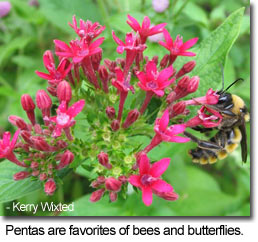
Annuals
Species |
Native? |
Flower/Fruit |
Benefits |
Flowering Tobacco
(Nicotiana alata) | N | May-Jul | Attractive to bees, butterflies and birds. |
Lantana
(Lantana camara) | N | Jun-Aug | Good for butterflies but invasive in southern climates like GA,FL |
Pentas
(Pentas spp.) | N | Jun-Sept | Nectar attracts bees, butterflies, birds |
Petunia
(Petunia spp.) | N | Apr-Jul | Can attract butterflies like Painted ladies |
Salvia
(Salvia spp.) | N | May-Sep | Great for beneficial insect pollinators |
Sweet William/Phlox
(Phlox divaricata) | Y | Apr-Jun | Showy spring flower that attracts butterflies |
Sweet William
(Dianthus barbatus) | N | Jun-Jul | Attracts butterflies and hummingbirds |
Zinnia | N | | Great for butterflies and other pollinators |
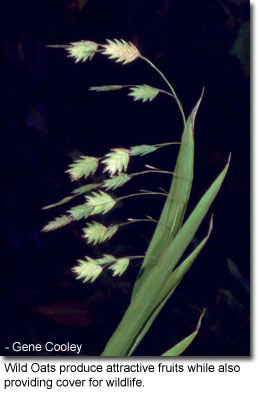
Grasses
Species |
Native? |
Flower/Fruit |
Benefits |
Big Bluestem
(Andropogon gerardii) | Y | Jun-Sep | Clump forming plant which provides cover; best in large containers |
Switchgrass
(Panicum virgatum) | Y | Jul-Oct | Clump forming plant which provides food for sparrows and other songbirds |
Wild Oats
(Chasmanthium latifolium) | Y | Jul-Sep | Provides cover |
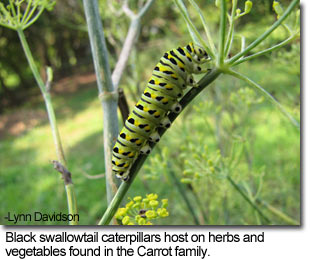
Herbs
Species |
Native? |
Flower/Fruit |
Benefits |
Dill
(Anethum graveolens) | N | | Host for Black swallowtail larvae |
Fennel
(Foeniculum vulgare) | N | | Host for Black swallowtail larvae |
Rosemary
(Rosemaryinus officinalis) | N | | Good for bees |
Parsley
(Petroselinum crispum) | N | | Host for Black swallowtail larvae |
Sweet Marjoram
(Origanum vulgare) | N | | Good for bees |
Thyme
(Thymus) | N | | Excellent for bees |
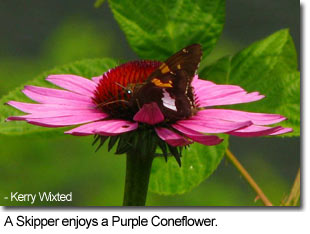
Perennials
Species |
Native? |
Flower/Fruit |
Benefits |
Beebalm
(Monarda didyma) | Y | Jul-Sep | Showy, aromatic flowers which attract hummingbirds and butterflies |
Beardtongue
(Penstemon digitalis) | Y | Jun-Aug | Great for hummingbirds |
Black-eyed Susan
(Rudbeckia hirta) | Y | Jun-Oct | Provides both a pollen and nectar source for wildlife |
Butterflyweed
(Asclepias tuberosa) | Y | May-Jul/
Aug-Nov | Host plant for monarch butterflies. Also attracts adult butterflies |
Creeping Phlox
(Phlox subulata) | Y | Apr-Jun | Attracts butterflies and works as a ground cover |
Moss Phlox
(Phlox subulata) | Y | Apr-Jun | Attracts butterflies and works as a ground cover |
Purple Coneflower
(Echinacea purpureum) | Y | Jul-Aug | Provides nectar for pollinators as well as seeds for birds |
Stonecrops
(Sedum spp.) | Y/N | | Provides good groundcover and some varieties are used by butterflies |
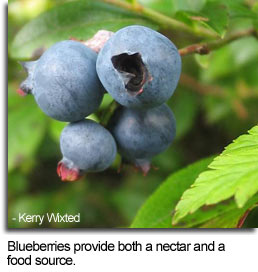
Shrubs for Tubs
Species |
Native? |
Flower/Fruit |
Benefits |
Blueberries
(Vaccinium spp.) | Y/N | | Provide berry source for birds as well as nectar source for butterflies and bees |
Camellia
(Camellia spp.) | N | | Can provide cover and some hummingbirds will use nectar |
Coralberry
(Symphoricarpos orbiculatus) | Y | Apr-Jun | Provides cover, nectar for insects, berries for songbirds and leaves for moths |
Hydrangea
(Hydrangea spp.) | Y/N | Jun-Aug | Provides cover and food for pollinators |
Juniper (dwarf varieties) | N | | Provides year-round shelter |
Virginia Sweetspire
(Itea virginica) | Y | Jun-Jul/
Aug-Mar | Provides nectar for beneficial insects and fruit for songbirds and small mammals |
Yew
(Taxus canadensis) | Y | Mar-May/
Jul-Sep | Provides cover and berries for songbirds |
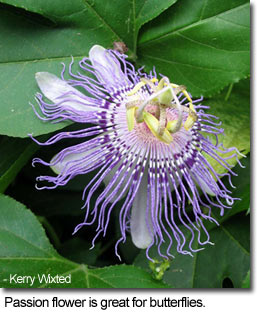
Vines
Species |
Native? |
Flower/Fruit |
Benefits |
Bittersweet
(Celastrus scandens) | Y | May-Jun/
Sept-Dec | Provides fruits, buds and leaves. Excellent winter food for birds. Oriental bittersweet (C. orbiculatus) is invasive. |
Passionflower
(Passiflora incarnata) | Y | Jun-Sep/
Sep-Oct | Great for butterflies and provides edible fruits |
Trumpet Creeper
(Campsis radicans) | Y | Jul-Sep/
Aug-Mar | Great for butterflies and hummingbirds |
Trumpet Honeysuckle
(Lonicera sempervirens) | Y | Apr-Oct/
Aug-Mar | Excellent plant for hummingbirds and provides berries for songbirds |
Virgin’s Bower
(Clematis virginiana) | Y | Jul-Sept/
Aug-Nov | Fragrant flowers |
Click here for a PDF version of this webpage for printing or reading purposes.
Invite Wildlife to Your Backyard!
For Additional Information, Contact:
Maryland Department of Natural Resources
Wildlife and Heritage Service
Tawes State Office Building, E-1
Annapolis MD 21401
410-260-8540
Toll-free in Maryland: 1-877-620-8DNR
[email protected]
Acknowledgements:
- Photograph of Black swallowtail caterpillar by Lynn Davidson
- All other photos by Kerry Wixted